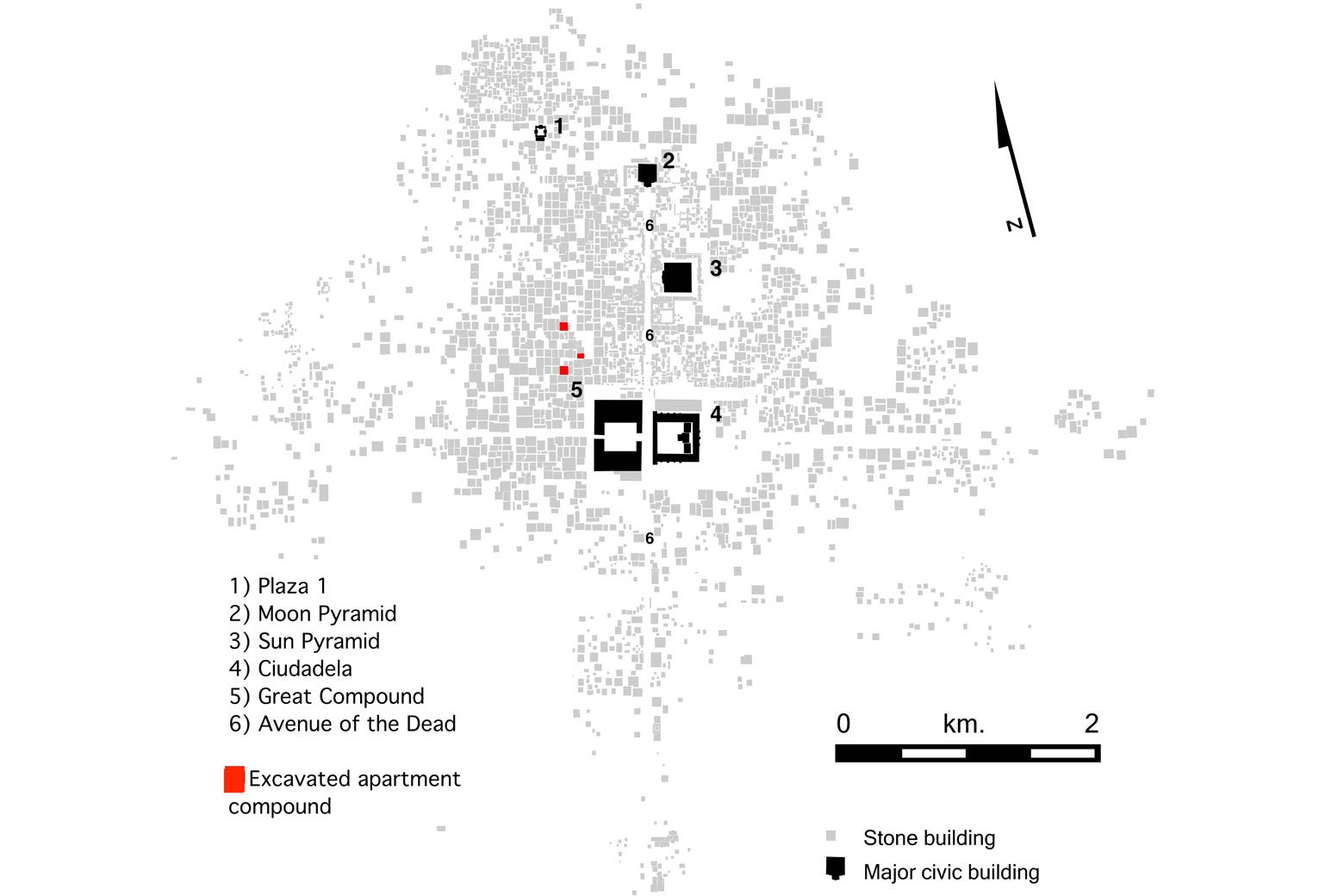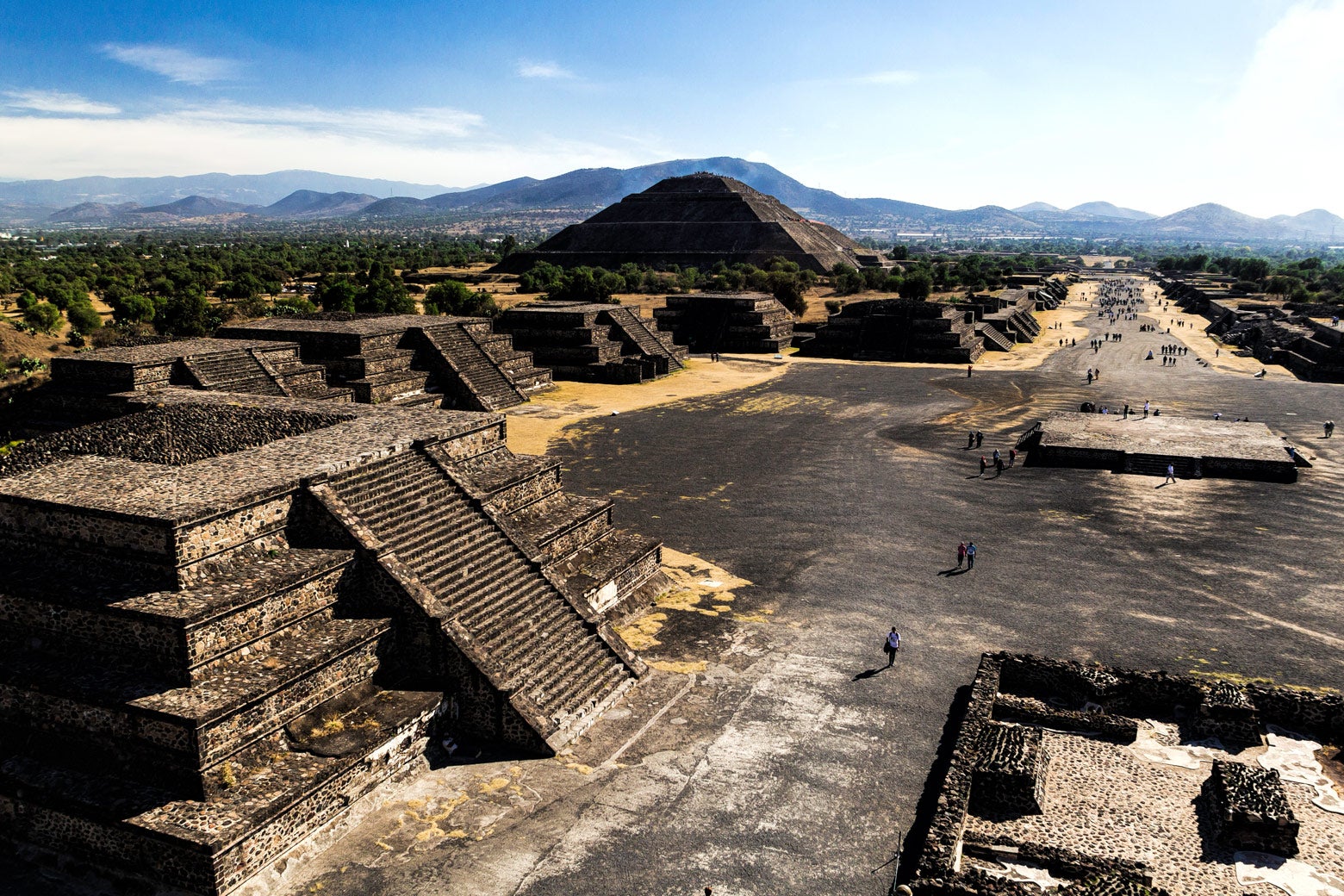This story was originally published in Spanish by HuffPost Mexico. A version of it has been adapted and republished here in English with permission from HuffPost Mexico.
Millions of tourists visit the ruins of Teotihuacán every year. They climb the pyramids, walk the Avenue of the Dead, and learn about the spectacular artifacts recovered from the ancient Mesoamerican city. Looking across the vast and remarkably well-preserved stone complex, built by hand by a pre-Aztec civilization, many likely assume that only a powerful despotic king—directing hordes of slave or serf laborers—could have orchestrated the construction of such a carefully planned city. Indeed, this is what archaeologists once believed. If tourists make the effort to visit some of the excavated residential compounds outside the main archaeological zone, however, they may start to understand why such assumptions about Teotihuacán society are changing. For these structures lie at the heart of our shifting perspective of the ancient city: namely, that it was far more egalitarian than we had previously imagined possible.
I began my archaeological career in the 1970s as an undergraduate examining artifacts at Teotihuacán. That first trip to Mexico cemented my love not only for the archaeology, but also for Mexican life and culture. In the decades since, I moved on to excavating Aztec-period sites in the provinces of that civilization’s empire. In 2015, when I was appointed director of Arizona State University’s archaeological lab in San Juan Teotihuacán, I got to return to my first love among Mexican sites, armed with new ideas about ancient cities and urban life. But after just a few years of work, I began to see Teotihuacán in a very different light.
Compared with the Aztec sites I have studied, Teotihuacán seems very strange, and not just because of its huge size (100,000 people, living in an area of close to 20 square kilometers). For one, it’s the only pre-modern Mexican city completely planned with a grid layout. For another, its residents lived in a form of housing—apartmentlike multifamily compounds with white lime-plaster floors, ornamented roofs, and porches—remarkably spacious and luxurious for the ancient world. These complexes are key to the conclusion of many researchers, including myself, that the city’s residents lived far more economically equal lives than any other known Mesoamerican society.
These new insights into Teotihuacán have come thanks to extensive fieldwork on the site. This includes decades of study from archaeologists excavating the pyramids and apartment compounds, who have helped to more fully reconstruct the architecture of the long-abandoned city and unearthed artifacts that are giving us clues about the lives of the people who inhabited it. It also includes work from anthropologists like René Millon and George Cowgill, who mapped the entire city and took more than 5,000 collections of artifacts from the surface of the ground. These materials are now stored in the lab I direct, where they are being studied by archaeologists.

From these labors, scientists studying the site have been able to present some remarkable theories. For one, we haven’t found any direct evidence of a king. The city’s extensive mural paintings contain no obvious images of royalty, and, to date, no one has found signs of a royal burial under the city’s pyramids. Archaeologists David Carballo at Boston University and Linda Manzanilla at the National Autonomous University of Mexico suggest that this is because Teotihuacán’s government may have been closer to a democracy than a dictatorship: It likely involved shared power, and the people may have had more say in selecting their ruler than in many ancient societies. Researchers like ASU’s Saburo Sugiyama, who works in our lab, on the other hand, think that the city’s carefully planned layout points to the work of a powerful despot whose tomb we have yet to find. However, comparative research shows that gridlike city planning can be carried out by nonautocratic societies. The ancient Greeks, for example, had grid-planned towns and democratic rule.
Other evidence, too, points to the idea that Teotihuacán society was exceptionally egalitarian. When Mexican archaeologist Laurette Séjourné first excavated one of Teotihuacán’s living compounds in the 1950s, she called it a “palace in the city of the gods.” This building—known as Zacuala—had large, spacious rooms with walls covered in colorful murals. Each living area had one or more patios open to the sky, with drains under the floors to channel rainwater out of the compound. Family members were buried in graves under the house floors, often with rich and elaborate offerings. As archaeologists unearthed more structures in the city, however, they found more and more that resembled Zacuala. Apparently, these seemingly luxurious living quarters were not reserved for the elite few, but housed thousands of residents. The Aztec commoner houses I excavated averaged only 25 square meters each (slightly smaller than two parking spaces), while a standard Teotihuacán family dwelling was over 200 square meters (about the size of a tennis court) in a compound of over 2,000 square meters (about one-third as large as the White House). Nearly everyone at Teotihuacán lived in a “palace.”

Yes, there are a few fancier residences, surely the homes of high-society families. But if most commoners lived in these palaces, it would appear that the quality of life for average residents was quite high. The presence of luxury goods in most compounds, including items imported from throughout Mexico, further supports this idea. If this was the case, Teotihuacán may have had the most prosperous residents of any city in the ancient world. This contradicts the common stereotype that ancient peoples were impoverished and powerless.
I decided to test this notion by quantifying the level of wealth inequality at Teotihuacán. To do this, I used a method devised by a group of archaeologists I work with who determine the wealth of individual families by measuring the sizes of their houses. We then use the Gini index—a measure of wealth concentration among a population—to calculate the level of inequality and compare it to other cities and settlements.
A Gini value of 1.0 indicates that a single household controls all of the wealth, while a value of 0 means that wealth is distributed equally among all households. Inequality is quite high in many nations today: The Gini index for Mexico is 0.75, and for the U.S., it is 0.80. Ancient Old World cities like Roman Pompeii and Egyptian Kahun have Gini values of about 0.6, and Aztec cities are in the range from 0.3 to 0.4. When a student calculated an initial Gini index of 0.12 for Teotihuacán, I assumed she had made an error and asked her to check her work. How could a huge city filled with big pyramids and stone buildings be so egalitarian? This must be a student error. Then I checked it myself: The low Gini value is indeed correct. The wealth of Teotihuacán, as measured by the size of houses, was remarkably evenly distributed among the population. Though there were a few larger, fancier houses and some small huts in the mix, more than 90 percent of the city’s population lived in the “palaces” of apartment compounds.
These findings that suggest this level of egalitarianism in Teotihuacán require a radical rethinking of the nature of life and society in the ancient city. Whether they support ideas like those from Manzanilla and Carballo that propose the government of the city was more collective than autocratic remains a topic of discussion. But the discoveries do suggest that it was possible for civilizations to create large and prosperous cities—in this case, one that flourished for five centuries—without the presence of a large underclass of poor, disenfranchised people.
How did the Teotihuacános accomplish this? Can we draw lessons from them for our cities today? We’re too early in our studies to draw definitive conclusions, but it’s possible that the city’s wealth from trading and other economic activity was spread throughout a population that lacked or even actively suppressed strong social class distinctions, and that some of that wealth went into providing quality housing for most residents. But further research should yield insights about urban life that will transcend the divide between ancient and modern cities—and may make the millions who visit Teotihuacán every year, and the rest of us, rethink what life in a city could look like.
